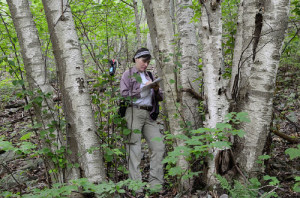We’ve come a long way since March 2014! Through collaboration with the Consortium of North American Bryophyte Herbaria, VBA was able to download all Virginia records on their bryophyte portal at that time. This effectively doubled the number of taxa in the Digital Atlas and added many hundreds of county records. Gary Fleming untangled the considerable problem of synonymy and names that have gone out of use. With volunteer assistance from Abby Hyduke, these were all mapped rather quickly. Many new records continue to come in due to a resurgence of interest in Virginia bryophytes. Principal collectors have been: John Townsend (state-wide), Tom Wieboldt and Ralph Lutts (southwestern mountains, primarily), John Bunch (Coastal Plain), and most significantly, the prolific collecting of Helen Hamilton in the Coastal Plain and, to a lesser extent, in other physiographic provinces. A highlight of this effort came in May 2016 when DCR-Natural Heritage contracted Dr. Paul Davison for a week of fieldwork to visit areas expected to be bryophyte “hotspots”. This yielded several state records including the very rare species, Lejeunea blomquistii, and a second record for Drepanolejeunea appalachiana.

One of the biggest challenges ahead is the addition of images for the moss and liverwort taxa. Field images are nice, but to actually be useful, microscope images are needed to reveal the identifying characters. This image of the common liverwort of decorticated wood, Nowellia curvifolia, is an example of a species that is too small to reveal its intricate leaves even in a close-up habitat image.
Lastly, habitat data is being added slowly through review of collection data on existing specimens, but this is often sketchy. It is hoped that more can be added from first-hand experience as we become familiar with these beautiful little members of the Virginia flora.
 The latest development on the Digital Atlas of the Virginia Flora website is the addition of Virginia’s mosses and liverworts. Initial data comes from two papers by David Breil published in Banisteria (liverworts in vol. 8:3-28 (1996); mosses in vol. 21:3-53 (2003)) and by other data compiled by him personally and never published. This draft “Bryophyte Atlas of Virginia” became available to VBA and forms the initial distribution maps to which additional records are being added as the information becomes available. There are many sources of additional records available today that were not readily available to Dr. Breil. The addition of county dots will be relatively quick and easy, but supporting documentation, as well as habitat descriptions and other comments will be a long term endeavor.
The latest development on the Digital Atlas of the Virginia Flora website is the addition of Virginia’s mosses and liverworts. Initial data comes from two papers by David Breil published in Banisteria (liverworts in vol. 8:3-28 (1996); mosses in vol. 21:3-53 (2003)) and by other data compiled by him personally and never published. This draft “Bryophyte Atlas of Virginia” became available to VBA and forms the initial distribution maps to which additional records are being added as the information becomes available. There are many sources of additional records available today that were not readily available to Dr. Breil. The addition of county dots will be relatively quick and easy, but supporting documentation, as well as habitat descriptions and other comments will be a long term endeavor.

